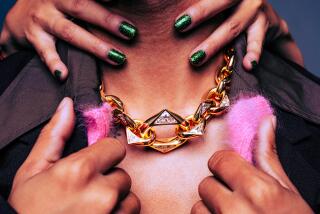Luster Returns to Jewelry Industry : Sales: Shopping channels are a gem to the business, as savvier buyers develop an eye for baubles both faux and genuine.
- Share via
NEW YORK — The sparkle has returned to the jewelry industry after years of, well, lusterless sales.
An improved economy, repeal of the luxury tax and new marketing options, such as home-shopping television, are behind the turnaround, which began a year ago.
“I think the confidence in wearing jewelry is coming back,” said Simon Teakle, who heads the U.S. jewelry division of Christie’s auction house, where 1993 sales rose 25% over the previous year.
“In recessionary times, it wasn’t socially correct to wear a tremendous amount of jewelry,” he said.
Teakle says consumers not only are buying more baubles and bangles but also have become savvier about what’s available. Many may know, for instance, that the finest red rubies come from Burma, that Mexican opals are fiery orange and that diamonds occur naturally in nearly every color of the rainbow.
Yet distinguishing a ruby from a red spinel, an emerald from a tsavorite garnet, or even 10-karat gold from 14-karat gold can be extremely difficult.
This lack of expertise--along with the availability of lab-grown synthetics and imitations resembling the real thing but usually worthless--can leave the average buyer vulnerable to unscrupulous dealers or suppliers.
“For every color you like, there are probably five or six gemstones in that color,” noted Antoinette L. Matlins, co-author of “Jewelry & Gems: The Buying Guide.” “What you see with the naked eye may not be reality when you buy gems and jewelry.”
What makes jewelry buying especially difficult is the fact that such purchases are often anchored with emotions, particularly during holidays like Valentine’s Day, among the busiest time for the industry.
Madison Avenue is largely responsible. Advertising campaigns portray diamonds and gems as the ultimate gift of eternal love.
The most successful of these campaigns comes from the De Beers’ cartel, which markets 80% of the world’s diamonds. De Beers has successfully perpetuated the illusion of the diamond as a rare and valuable stone. In reality, diamonds are plentiful but tightly distributed.
“There’s a tremendous exploitation of consumers based on the allure of gemstones and the mythology of them,” Matlins said.
“Someone on the TV shopping network may mention diamonds or rubies or sapphires or emeralds and a certain image instantly comes to mind . . . of having a highly valuable jewel. But in fact, it doesn’t escape the fact that it could be garbage.”
Steffan Aletti, president of the Jewelry Industry Council in New York, said he has received few complaints about the discounted jewelry sold on home-shopping programs. But he acknowledged there are some dealers who do misrepresent what they sell.
“There are some emeralds that are more appropriate to grace the bottom of a fish bowl than a ring,” he said. “The more desperate people are looking for a deal, the most likely they are to get stung.”
One way to avoid getting stung is to deal with reputable dealers, who have trade-group affiliations and experts on the payroll.
“You don’t need to be a gemologist to buy a ring,” Aletti said, “just as you don’t need to study a schematic to buy a Sony or a Panasonic” TV.
Still, there are some basic rules to keep in mind when buying jewelry.
For diamonds, size isn’t the most important factor. Diamonds are graded and priced based on cut, color, clarity and carat weight, with a flawless, colorless stone considered the most valuable.
A half-carat, round-cut diamond that’s nearly flawless and with excellent color can cost far more than a 3-carat diamond with poor color and noticeable imperfections--about $13,400 vs. $7,200, Matlins’ book says. Fancy shapes usually sell for about 5% to 15% less.
Matlins says the four Cs for gemstones are “color, color, color, and color!”
If the color is good, she says, the presence of flaws usually won’t detract from the stone’s value as significantly as with diamonds. Keep in mind, however, many stones are treated with heat or oils to enhance their color, a process that is legal so long as the dealer discloses that to the customer.
The availability of the stone is also crucial. A chrome tourmaline may have a color similar to a green zircon, but because there’s less supply, the tourmaline costs more--about $300 to $1,400 for 1 to 3 carats vs. $240 to $680, says “Jewelry & Gems.”






